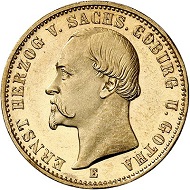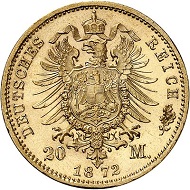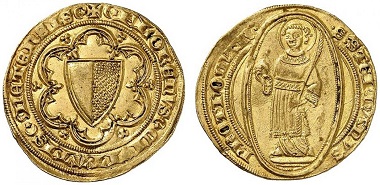15-05-2017 – 16-05-2017
Auction 71 and 72
Excellent Results at Grün in Heidelberg
On May 16 and 17, 2017, the Heidelberger Münzhandlung conducted its two Spring Auctions No. 71 and 72. As always, many coins stood out, not only due to their rarity but above all due to their excellent grade, and this was clearly reflected in the results.
Lot 4170: German Empire. Saxe-Coburg-Gotha. Ernst II, 1844-1893. 20 marks 1872. The rarest of all gold coin types of the German Empire, in a fine grade. Almost FDC. Estimate: 75,000 euros. Hammer price: 116,000 euros.
75,000 euros had been the pre-sale estimate of the rarest of all gold coins of the German Empire, 20 marks from 1872 in the best grade possible. Apart from tiniest scratches, this specimen was almost FDC. It became the most expensive coin of the auction when it brought 116,000 euros. This was an impressive result that very likely would have pleased Duke Ernst II of Saxony-Coburg-Gotha, who is depicted on the coin, as well.
He was the elder brother of English Prince Consort Albert and was known for his love for luxury and pomp. Earlier in his life, though, he had made a name for himself as a representative of the liberal national movement. He vigorously supported the unification of the German states to the German Empire. It is thus for a good reason that Ernst II is shown on the famous painting by Anton Werner, which features Wilhelm I being proclaimed German Emperor. Ernst is shown standing on the podium on the very left, highlighted through his white uniform. His devotion to the new German Empire is the background of Ernst issuing 1,000 specimens of the 20 marks piece in 1872, in accordance with the new Minting Ordinance They were not intended to be used for payment purposes, but as gifts.
Lot 2715: Brandenburg-Ansbach. Carl Wilhelm Friedrich, 1729-1757. Gold strike of 12 ducats of the 2nd falkentaler. Unedited in this weight in gold. Extremely rare. Extremely fine. Estimate: 25,000 euros. Hammer price: 80,000 euros.
The commissioner of this hitherto unpublished gold strike in the weight of 12 ducats of the 2nd ‘falkentaler’ went down in history as the ‘Wild’ Margrave. Historians used to accuse him of having spent enormous sums of money on falconry, while his country was facing state bankruptcy. Today, academic research takes a more balanced view, emphasizing the importance of falconry in the Baroque court ceremonial and the prestige that Carl Wilhelm Friedrich gained from it.
Just as grand buildings or elaborate opera performances, falconry was extremely expensive and was thus interpreted by the contemporaries as a reflection of wealth. Besides, falconry had a centuries-old tradition as a ‘pleasure of the princes’ (= oblectamina principis), as it can also be read on this falkentaler. As Emperor Frederick II had already written in his book on hunting with birds, it also required strength of will and benevolence – qualities that were equally expected from a ruler in the times of absolutism. Carl Wilhelm Friedrich was renowned throughout Europe for his falconry with its 51 employees. Becoming known far and wide through his passion, his degree of familiarity clearly surpassed the importance of his relatively small principality. It is no wonder then that he chose falconry as a motif for coins, particularly for those intended to serve as gift to foreign ambassadors and princes.
Auctioned by the Heidelberger Münzhandlung for 80,000(!) euros, the gold coin in its perfect grade depicts the prince himself, on a galloping horse, watching his falcon beating a heron. The entourage, though usually present during such a hunt, is not shown. We only see three horsemen, two with trumpets and one with a drum who accompany the event with music as it was customary in these days.
Lot 3153: Saxony, Albertine Line. Friedrich August I, 1694-1733. 5 ducats 1714, Gold strike of the 1/2 taler. Unedited! Extremely fine. Estimate: 30,000 euros. Hammer price: 68,000 euros.
An impressive 68,000 euros was the price for the unedited five ducats piece of Friedrich August I, nicknamed The Strong, which he had minted as a strike of the 1/2 taler in 1714. This coin was probably intended as a gift as well, to be given to ambassadors, princes, or local noblemen who, at least once a year, were given a gift at the turn of the year.
Lot 1820: Lorraine. René II, 1473-1508. Florin d’or, no date, Nancy. Very rare. Extremely fine. Estimate: 7,500 euros. Hammer price: 9,000 euros.
Auction 71 of the Heidelberger Münzhandlung offered one of the major Lorraine collections seen on the market in the last decades. If you want to know more about this collecting area, please read our article of the week. There, we present to you the most spectacular pieces of the collection.
Lot 2024: Metz, City. Florin d’or, no date (15th cent.). Extremely fine. Estimate: 600 euros. Hammer price: 3,100 euros.
Lorraine only made the core of the large series of French féodal coins. Amounting to almost 500 in number, all obtained very satisfying results. This is a list of some of the most outstanding results in this section:
- 1844: Lorraine. Charles III, 1545-1608. Écu 1557. Rare. Very fine. Estimate: 3,000 euros. Hammer price: 5,100 euros
- 1857: Lorraine. Charles III, 1545-1608. Écu 1575, Nancy. Very rare. Almost very fine / Very fine. Estimate: 3,500 euros. Hammer price: 5,600 euros
- 1867: Lorraine. Charles III, 1545-1608. Double pistole no date (1581-1608). Extremely rare. Very fine. Estimate: 10,000 euros. Hammer price: 12,000 euros
- 1880: Lorraine. Charles IV, 1625-1634. Double pistole 1631. Extremely rare. Very fine. Estimate: 10,000 euros. Hammer price: 10,500 euros
- 1885: Lorraine. Charles IV, 1661-1670. Charles d’or 1663. Very rare. Extremely fine to FDC. Estimate: 7,500 euros. Hammer price: 8,500 euros
- 1985: Lorraine. Francois III, 1729-1736. Double teston 1736. Very fine to extremely fine. Estimate: 1,500 euros. Hammer price: 3,100 euros
- 2021: Metz, Bishopric. Robert de Lenoncourt, 1551-1555. Écu 1551. Very rare. Extremely fine. Estimate: 6,000 euros. Hammer price: 6,250 euros
- 2024: Metz, City. Florin d’or, no date (15th cent.). Extremely fine. Estimate: 600 euros. Hammer price: 3,100 euros
- 2037: Orange, Principality. Wilhelm IX, 1647-1650. Half écu 1649. Very rare. Very fine to extremely fine. Estimate: 5,000 euros. Hammer price: 7,500 euros
Lot 259: 1 mark 1873 C. FDC. Estimate: 6,500 euros. Hammer price: 9,500 euros.
Forming part of the collection offered in Auction 72, the fractions in their perfect grade brought impressive results, too. As was to be expected, the rare coins, available in exquisite grades, were very much sought after with collectors.
Lot 309: 1 mark 1881 G. Fine patina. FDC. Estimate: 7,500 euros. Hammer price 13,000 euros.
Selling for an impressive hammer price of 13,000 euros on an estimate of 7,500 euros, a 1 mark 1881 G, that had not only been graded FDC but also displayed a particularly fine patina, became the most expensive item of the auction.
Here are some more results:
- 31: 1 pfennig 1877 B. Extremely rare. FDC. Estimate: 2,000 euros. Hammer price: 2,600 euros
- 65: 2 pfennig 1873 G. Very rare. Almost FDC. Estimate: 500 euros. Hammer price: 1,000 euros
- 289: 1 mark 1877 B. Extremely rare. FDC. Estimate: 3,000 euros. Hammer price: 5,750 euros
- 580: 5 pfennigs 1896 G. Extremely rare! One of the best examples known. Very fine+. Estimate: 6,000 euros. Hammer price: 6,700 euros
- 701: 10 pfennigs 1894 E. Very rare. First strike. FDC. Estimate: 500 euros. Hammer price: 1,000 euros
- 829: 50 pfennigs 1902 F. Extremely rare. Proof. Estimate: 1,250 euros. Hammer price: 2,100 euros
- 898: 1 mark 1893 F. Very rare. First strike. FDC. Estimate: 400 euros. Hammer price: 1,100 euros
- 944: 1 mark 1904 J. Very rare. FDC. Estimate: 750 euros. Hammer price: 1,200 euros
- 1196: 50 reichspfennigs 1924 F. Extremely rare. First strike. Almost FDC. Estimate: 7,500 euros. Hammer price: 9,750 euros
- 1240: 50 reichspfennigs 1931 J. Very rare. Proof. Estimate: 500 euros. Hammer price: 1,300 euros
You can download all results from the homepage of the Heidelberger Münzhandlung.
Consignments for the upcoming auction, scheduled for November 2017, are welcomed as of now. Please contact Heidelberger Münzhandlung Herbert Grün, Gaisbergstr. 40, 69115 Heidelberg; phone: ++49 / 6221 / 65 2970; fax: ++49 / 6221 / 65 297-29; e-mail or through the website’s contact request.

















